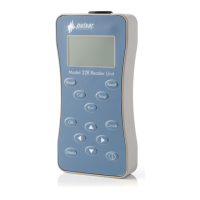dosemeter User Manual
Page 63
Appendix 3 dosemeter Calibration
As with all noise instruments, calibration is an essential part of the process of making a
measurement and helps to ensure that your measurements are accurate and valid. It
also helps to ensure that your equipment is operating correctly.
When calibrating your noise measurement instruments, you should always follow the
instructions and information provided by the manufacturer.
This section provides detailed information regarding the calibration of the dosemeter
system.
First Calibration
The initial calibration of the dosemeter, after the unit has been reset by the MODEL 22R
Reader, is the only one that affects the measurement data.
The second calibration, which is made after the measurement had been completed, is a
check that the calibration level is within acceptable tolerances.
Resetting the dosemeter prepares it for a new measurement by clearing all previous
data, ensuring the time and date are correct, setting the required measurement
parameters and clearing any previous calibration offsets or corrections.
The first calibration is conducted by applying a fixed sound pressure level of 114dB to
the dosemeter from the MODEL 22R Reader, internally reading the levels reported by
the dosemeter and then storing a calibration offset within the dosemeter.
This calibration offset is subsequently used by the Reader to correct the data measured.
There is no user requirement to apply this offset as it is applied automatically by the
dosemeter.
All the data reported by the Reader and the Pulsar AnalyzerPlus software is already
corrected and no further corrections or adjustments are needed.
Calibration offsets between +/-0.3dB are accepted within the dosemeter.
Second Calibration
Once the first calibration has been carried out, any subsequent calibration will follow
the same process expect that a new calibration offset is not stored nor applied.
Subsequent calibrations are checks only and do not affect the measurement data (only
the calibration offset from the first calibration is applied).
The Reader device reports subsequent calibrations as a 'drift'.
The drift is considered to be the difference between the actual calibration offset (from
the first calibration) and the notional offset from subsequent calibration checks.
There is no limit to the amount of drift reported by the second calibration.

